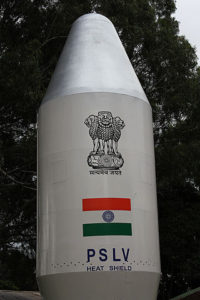
Indian Space Research Organization (ISRO) is all set to create a new world record next week by launching 104 satellites through its workhorse PSLV-C37 rocket. The lift-off is expected to take place on 15th, and now ISRO says it is expecting to recover half the cost of the mission by launching foreign satellites.
Out of 104 satellites, only 3 belong to India (including Cartosat-2D) and the rest 101 satellites are foreign satellites. PSLV will place the satellites in the lower orbit of the earth for monitoring the planet. Earlier, PSLV launch was scheduled for January, when it would have carried 83 satellites, but the launch was postponed to February. A successful launch of PSLV and the mission will make ISRO the first agency in the world to launch record number satellites beating the previous record of 37 satellites by Russia in June 2014. Before Russia, NASA held the title when it sent 29 satellites at one single move on November 19, 2013.
“We want to make optimum use of our capacity. We are launching our three satellites. One is of 730 kgs while other two are 19 kgs each. We had additional space of 600 kgs. So we decided to accommodate 101 satellites,” ISRO chairman A S Kiran Kumar said.
Although Kiran Kumar didn’t reveal the cost of the launch, he revealed that the Indian space agency will recover about half of the cost by launching foreign satellites.
“Roughly half of our cost will be covered by the foreign satellites we are launching,” he said.
Eight-eight satellites belong to the United States (Dove cubesets from Earth-imaging firm Planet), and the rest 13 are from other foreign nations like Israel, Germany, Kazakhstan, Switzerland, the Netherlands, and the United Arab Emirates.
The launch will take place from Satish Dhawan Space Centre in Sriharikota in Andhra Pradesh on 15th February, at around 9 a.m.
“A 320-tonne launcher rocket – PSLV-C37 (Polar Satellite Launch Vehicle) will mark the discharge of the satellites with a collective weight of 1,500 kg,” the statement from an ISRO official read.
“It also includes a Cartosat-2D which weights 650kg and two nano-satellites called INS-1A and INS-1B, weighing 15 kg each. Similarly, the combined mass of 100 foreign micro-satellites will be 820 kg in total.”
Founded in 1969 and headquartered in Bengaluru, ISRO is the space agency of India that was created with an aim to lead India in space science research and planetary exploration. The vision of ISRO is to “harness space technology for national development”.
Prior to ISRO, Indian National Committee for Space Research (INCOSPAR), created in 1962, was responsible for managing space research program in India. India’s Department of Space, which reports to the Prime Minister of India, manages all the activities of ISRO.
India’s first satellite, Aryabhata, was made by ISRO. Named after Indian mathematician Aryabhata, the satellite was launched in 1975 by the Soviet Union. In 1980, ISRO got success in placing the Rohini satellite in orbit using an Indian-made launch vehicle, SLV-3. Over the years, ISRO successfully developed two other Rockets – the Polar Satellite Launch Vehicle (PSLV) and the Geosynchronous Satellite Launch Vehicle (GSLV) – for launching satellites into polar and geostationary orbits respectively.
In the past three decades, these rockets have put several communications and earth observation satellites in orbits.
ISRO grabbed the attention of the whole world by creating lunar orbiter Chandrayaan-1and Mars Orbiter Mission (MOS). Chandrayaan-1 was sent to moon on 22 October 2008. MOS also got success in entering the Mars orbit on 24 September 2014, thus making India the world’s first nation to succeed on its first attempt. India also became the first space agency in Asia and fourth in the world to have successfully reached Mars orbit.
In May 2016, India successfully launched its first-ever indigenous space shuttle – the Re-Usable Launch Vehicle – Technology Demonstrator (RLV-TD) from Sriharikota in Andhra Pradesh.
RLV-TD, the country’s first winged-body aerospace vehicle, is being said to be the ISRO’s first step towards developing a reusable launch vehicle that would be capable of sending spacecraft into orbit and then returning to the Earth. After this technology is developed completely, it would be possible to launch spacecraft, including satellites, into space and make them re-enter earth’s atmosphere. During re-entry, the spacecraft would withstand extreme pressure and heat conditions, and then land in at an intended spot. The technology would substantially reduce costs of launch of space vehicles.